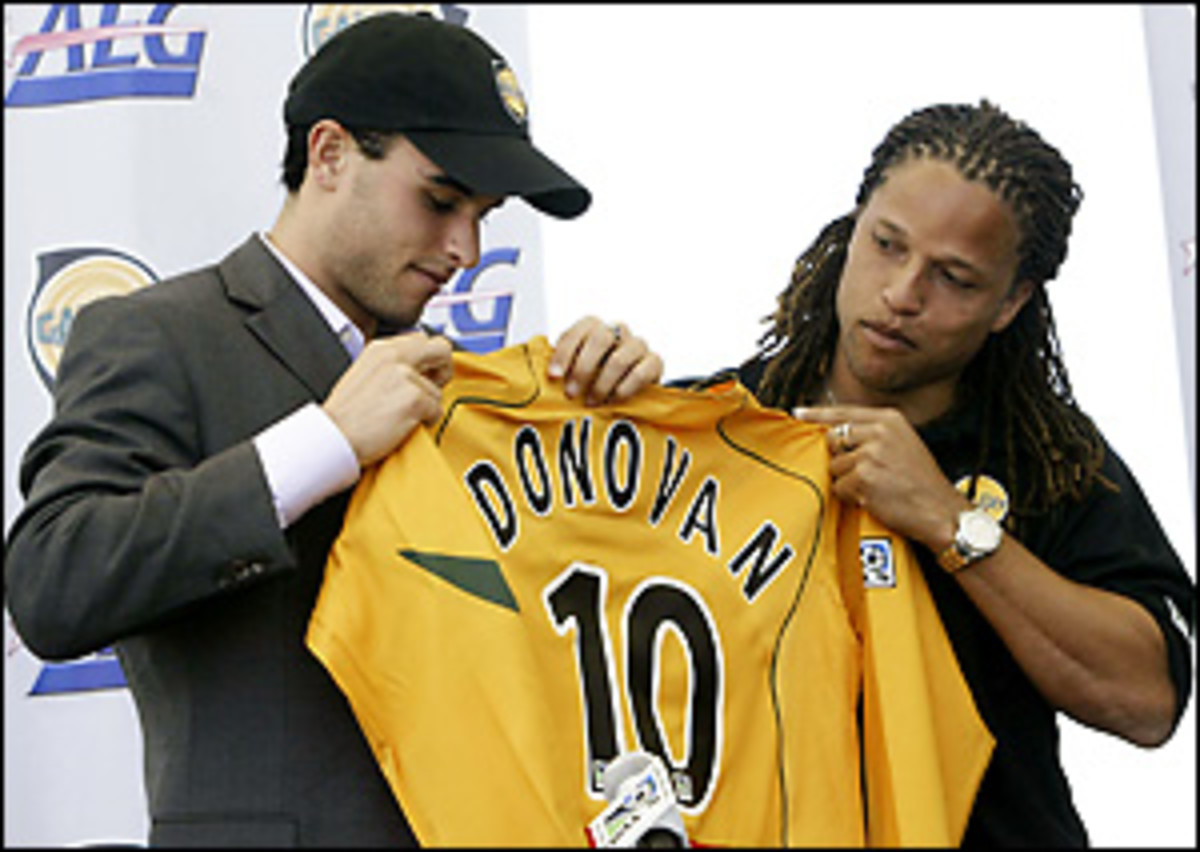MLS looking to score
He wasn't entirely correct. As Major League Soccer kicks off its 10th season this weekend, the league finally does appear to be picking up some steam in a country famously fickle about the sport. TV ratings are up slightly. Endorsement dollars are increasing. Visible American stars are returning after playing abroad. The league is expanding for the first time since 1998. And, most important, MLS may be on the verge of turning its first profit.
League executives are excited, but privately they'll admit that supplanting the dormant NHL as the No. 4 big-time sports league in the America isn't a reasonable goal yet. But it should be. For the first time, the planets appear to be aligned for MLS, and 2005 will be a crucial year for several reasons:
Two of America's most electric stars are back in the fold. Landon Donovan, who has become the de facto ambassador of U.S. soccer, returns from Germany to anchor the L.A. Galaxy. Donovan is quickly inheriting the title "face of the game" from '90s icons Alexi Lalas and Cobi Jones. Clint Mathis, who also returns from the Bundesliga, is the poster boy of the expansion team Real Salt Lake. He's the closest thing American soccer has to Dennis Rodman in his prime: a huge talent with an outsized and unpredictable personality.
American soccer fans should rejoice, because our next star is here to stay. MLS made a huge statement in March when it turned down a $4 million transfer offer from Portuguese club Benfica for FC Dallas' Eddie Johnson. After losing DaMarcus Beasley to the Dutch league and Tim Howard to the English Premiership, MLS knew it had to draw a line in the sand if it's to keep its young talent, and the 21-year-old Johnson is the league's biggest up-and-coming star. (If you saw his thrilling bicycle-kick shot on goal during Team USA's qualifying match against Guatemala, you know what I'm talking about.)
Elsewhere in the league, other stars in the making fill out team rosters, and they're representatives of a generation that never experienced the American soccer malaise of most of the 20th century. Players such as Johnson, New England's Clint Dempsey, Columbus' Chad Marshall, MetroStars' Eddie Gaven and DC United's Alecko Eskandarian grew up playing the game in AYSO and other youth leagues. For the 14 millions kids who play youth soccer, these guys are accessible potential heroes.
MLS is banking big on two expansion teams this season, and their success will be a barometer of the league's future. The first, Chivas USA, should be a natural fit in Los Angeles. The team is an offshoot of Chivas Rayadas de Guadalajara, the hugely popular Mexican team (both clubs are owned by Mexican tycoon Jorge Vergara). MLS figures the Chivas brand will resonate in L.A., which has the biggest Mexican population of any American city. And, as former MLS co-founder and former commissioner Don Logan points out, the majority of Mexican immigrants from the soccer-crazed Guadalajara region settle in Southern California. The Galaxy already has a large Hispanic following, and Chivas will steal some of it away, making L.A. the league's first two-team town. Strengthening a budding rivalry is the fact that both teams will play in the Home Depot Center in Carson, Calif.
The second team, Real Salt Lake, will be a much bigger test. Outside of the Utah Jazz, Salt Lake City doesn't exactly scream "international-sporting Mecca." But the man behind Real Salt Lake is the charismatic entrepreneur and former New York Knicks/Madison Square Garden honcho Dave Checketts, a native Utahn. He and his executive team are betting on a market that has an exponentially growing Hispanic population and reportedly the highest per-capita participation in organized soccer of any American metropolitan area. The club has a solid roster (headed up by Mathis) that should be a successful draw in its first season. If MLS can pull this off, it may prove its sustained health.
If the league is to become an institution, it needs to make sure its players are marketable. They can be, and here's why: NBA players earn not only the highest salaries of American athletes, they make the most endorsement dollars. That's partly due to the fact that we can see them -- Peyton Manning is covered in protective gear and Barry Bonds bats five times a game, but Allen Iverson's face and cornrows are visible for all 48 minutes of an NBA contest.
Soccer players have that same advantage: Fans can see their faces while they play all of a 90-minute match (in close-ups, anyway). And while American players haven't been as recognizable in the past, they're becoming more marketable. DC United's Freddy Adu, for instance, rakes in about $2.5 million a year endorsing Nike, Sierra Mist, EA Games and Campbell's Soup. True, that's nowhere near LeBron James' $21 million a year. But Adu is the highest-grossing American soccer player, both in salary and endorsement dollars -- and he isn't even old enough to drive yet.
As far as big corporate deals, MLS scored perhaps its biggest vote of confidence last year from one of the world's foremost sports authorities when Adidas agreed to endorse the league for 10 years to the tune of $150 million. Meanwhile, new soccer-only stadiums are being built in Dallas, Salt Lake City, Chicago and, soon, New Jersey. All this is added pressure for the league, which knows there's a lot riding on this big money, and investors will be watching closely.
On the field, it should be an exciting season. And as the action wraps up at the MLS Cup game in Dallas in November, World Cup buzz will be kicking it into high gear. Just one more piece of MLS' longterm puzzle.





